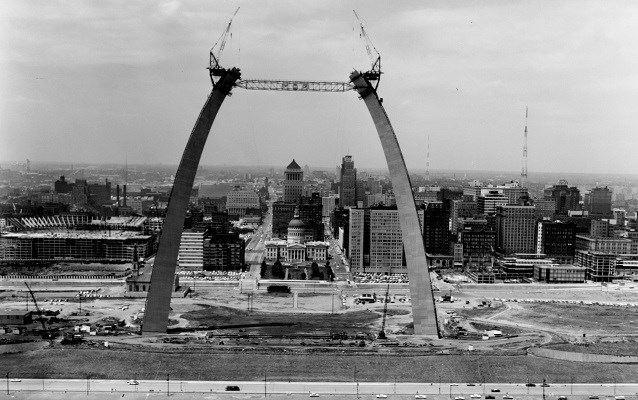Last updated: February 20, 2018
Article
Jefferson National Expansion Memorial

The Jefferson National Expansion Memorial in St. Louis, Missouri commemorates Thomas Jefferson's vision of the continental expansion of the United States, evidenced by the Lewis and Clark Expedition. President Jefferson's instructions to Lewis and Clark included.
“. . .the object of your mission is to explore the Missouri river, & such principal streams of it, as, by its course & communication with the waters of the Pacific Ocean, may offer the most direct & practicable water communication across this continent, for the purposes of commerce . . ."
In December 1803, Clark established "Camp River Dubois" on the Wood River, north of St. Louis, Missouri. While there, Clark's responsibility to train the many different men who had volunteered to go on the expedition and turn them into an efficient team. Meanwhile, Lewis spent the winter in St. Louis, then a Spanish controlled town of 900 inhabitants, gathering supplies and equipment for the journey. On March 9, 1804, Lewis attended a special ceremony in St. Louis, during which the Upper Louisiana Territory was transferred to the United States. All the land from the Mississippi River to the tops of the Rocky Mountains now officially belonged to the United States. Two months later the expedition was ready to begin. Clark and the men went to St. Charles, Missouri, where Lewis joined them a week later.
The Jefferson National Expansion Memorial is comprised of the Gateway Arch (a National Historic Landmark), the Museum of Westward Expansion, and St. Louis' Old Courthouse. Architect Eero Saarinen's design for a 630-foot stainless steel catenary arch was selected in a 1947 design competition as the ideal monument to the spirit of the western pioneers. However, construction on the Gateway Arch did not begin until the 1960s. The Arch, the tallest monument in the United States, cost less than $15 million and was built to withstand high winds and earthquakes. Below the Gateway Arch lies the Museum of Westward Expansion, which houses an extensive collection of artifacts and an overview of the Lewis and Clark Expedition. The nearby Old Courthouse, built in 1839, is one of the oldest existing buildings in St.Louis.

NPS Photo
The Jefferson National Expansion Memorial is a High Potential Historic Site on the Lewis and Clark National Historic Trail.
During the expedition’s 1803-1804 winter encampment at Wood River, Lewis spent the majority of his time in the St. Louis area obtaining supplies, information, and new recruits. On March 9-10, 1804, Lewis attended ceremonies in St. Louis that marked the transfer of Upper Louisiana from France to the United States.
St. Louis was founded by French settlers in 1764 and developed as a center of French culture and Spanish power. With the United States’ Louisiana Purchase in 1803, it soon became a major point of departure for western-bound emigrants. The Jefferson National Expansion Memorial is on the site of the original downtown. The memorial comprises the Gateway Arch (a National Historic Landmark), the Museum of Westward Expansion, and St. Louis’ Old Courthouse. Architect Eero Saarinen’s design for a 630-foot stainless steel catenary arch was selected in 1947, and construction began in the 1960s. The Gateway Arch is the tallest monument in the United States. Below the Arch lies the Museum of Westward Expansion, which houses an extensive collection of artifacts and an overview of the Lewis and Clark Expedition. The nearby Old Courthouse, built in 1839, is one of the oldest extant buildings in St. Louis.
